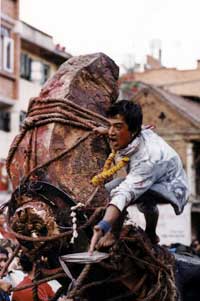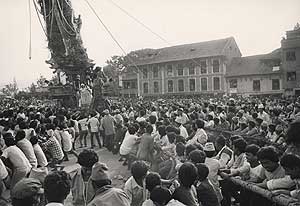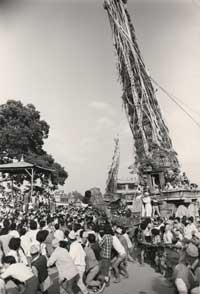 The 12-year festival of Bungadya that has just concluded is a festival that both Hindu and Buddhist Newars insist everyone should attend at least once in their lifetime. It is the large-scale version of the largest of Kathmandu Valley's innumerable annual festivals, and the god it honours is known by many names, Rato Matsyendranath and Karunamaya among them. This enormous chariot festival is inextricably woven into the lives of the Valley residents, and serves as a marker to reflect on what has changed not only in the festival itself, but also in the lives of those who have celebrated the tradition for more than a 1000 years. This year's jatra was different from the one I saw two decades ago when I first started studying them as an anthropologist, but at many moments it was almost eerily identical. Some of the changes were predictable results of abandoned tradition, but others were products of vital cultural innovation and revival.
The 12-year festival of Bungadya that has just concluded is a festival that both Hindu and Buddhist Newars insist everyone should attend at least once in their lifetime. It is the large-scale version of the largest of Kathmandu Valley's innumerable annual festivals, and the god it honours is known by many names, Rato Matsyendranath and Karunamaya among them. This enormous chariot festival is inextricably woven into the lives of the Valley residents, and serves as a marker to reflect on what has changed not only in the festival itself, but also in the lives of those who have celebrated the tradition for more than a 1000 years. This year's jatra was different from the one I saw two decades ago when I first started studying them as an anthropologist, but at many moments it was almost eerily identical. Some of the changes were predictable results of abandoned tradition, but others were products of vital cultural innovation and revival.  Several of the changes due to cultural attrition are those that very few would notice, for they are apparent only early in the morning and late in the evening. Daily devotional activities at the chariot begin at around 3:30 in the morning, and build to a climax with the morning nitya puja around daybreak, when hundreds of people come, hoping to glimpse the god's face in the mirror in which Bungadya's reflection has been ritually bathed. Twenty years ago the pre-dawn was first filled with the sounds of the singers of the Namsangiti hymns, and then of various bhajans playing chime-like cymbals, horns and large double-ended drums. Musical groups would arrive in procession from various parts of the town, their drumming and clanging cymbals becoming louder as they reached the rath. After the nitya puja climax, and people had rushed forward to be sprinkled with the prasad of Bungadya's bathing water, the tuta bhajans would, one by one, take their place first in front of Bungadya's chariot, and then in front of the smaller chariot of Chakwadya, to sing hymns praising Bungadya in the various manifestations in which he is recognised.
Several of the changes due to cultural attrition are those that very few would notice, for they are apparent only early in the morning and late in the evening. Daily devotional activities at the chariot begin at around 3:30 in the morning, and build to a climax with the morning nitya puja around daybreak, when hundreds of people come, hoping to glimpse the god's face in the mirror in which Bungadya's reflection has been ritually bathed. Twenty years ago the pre-dawn was first filled with the sounds of the singers of the Namsangiti hymns, and then of various bhajans playing chime-like cymbals, horns and large double-ended drums. Musical groups would arrive in procession from various parts of the town, their drumming and clanging cymbals becoming louder as they reached the rath. After the nitya puja climax, and people had rushed forward to be sprinkled with the prasad of Bungadya's bathing water, the tuta bhajans would, one by one, take their place first in front of Bungadya's chariot, and then in front of the smaller chariot of Chakwadya, to sing hymns praising Bungadya in the various manifestations in which he is recognised.
Quieter, shorter  This wonderful cacophony of morning praise can still be heard, though it is now quieter and shorter than it was two decades ago. The Namsangiti singers are still in force, though few newcomers are among them, and there are fewer instrumental groups than before. Those who remain to sing and play every morning cite the increasing demands of office work, tighter schedules and declining interest as reasons for these changes, but this is difficult to ascertain, as it is hard to talk to those who now are absent, or who might have otherwise been inspired to join in the morning rites of wakening.
This wonderful cacophony of morning praise can still be heard, though it is now quieter and shorter than it was two decades ago. The Namsangiti singers are still in force, though few newcomers are among them, and there are fewer instrumental groups than before. Those who remain to sing and play every morning cite the increasing demands of office work, tighter schedules and declining interest as reasons for these changes, but this is difficult to ascertain, as it is hard to talk to those who now are absent, or who might have otherwise been inspired to join in the morning rites of wakening.
If the morning brings a chorus of sound to the chariots, the evening brings a festival of lights, and there was certainly no shortage of batti burners at the rath this year. Twenty years ago, however, among the many lamps burning around the chariot, one could often detect the form of a supine worshipper or two, swathed in cloth, and shielded with daubs of cow dung, topped with clay saucers of oil, burning with lighted wicks. This year's jatra saw only one mhe matta chyakemha, from Thimi, fulfilling a vow at Jawalakhel, accompanied by members of his family, who refilled the salicas with oil so that he might burn 360 over the course of the night.  Far more visible, though paradoxically a bit less clear, are changes in the way the rath is pulled. There used to be a more general consensus about where the rath should stop along its route, and it is generally agreed that the rath pullers used to be more respectful of the decisions made by the gurujuya paltan as to when to call it quits for the day. But the contrast between then and now is not as clear as I had first thought. I recall being surprised to see the pullers ignore the gurujuya paltan's ceremonial conclusion of the day's pulling during the last 12-year festival, and chalked it up to Nepalis being newly empowered by the jana andolan. However, elders recalled other jatras of earlier times in which the same thing had happened. This having been said, those who are most closely responsible for the welfare of the chariot agree that those who are pulling it now are less disciplined (and less skilled) than in the past. One of the Yangwals who lashes the rath together and often risks his life at the top of the rath in order to coordinate those pulling below told me that, these days, (with several clear exceptions) no one could say how far or late the rath would be pulled on any given day.
Far more visible, though paradoxically a bit less clear, are changes in the way the rath is pulled. There used to be a more general consensus about where the rath should stop along its route, and it is generally agreed that the rath pullers used to be more respectful of the decisions made by the gurujuya paltan as to when to call it quits for the day. But the contrast between then and now is not as clear as I had first thought. I recall being surprised to see the pullers ignore the gurujuya paltan's ceremonial conclusion of the day's pulling during the last 12-year festival, and chalked it up to Nepalis being newly empowered by the jana andolan. However, elders recalled other jatras of earlier times in which the same thing had happened. This having been said, those who are most closely responsible for the welfare of the chariot agree that those who are pulling it now are less disciplined (and less skilled) than in the past. One of the Yangwals who lashes the rath together and often risks his life at the top of the rath in order to coordinate those pulling below told me that, these days, (with several clear exceptions) no one could say how far or late the rath would be pulled on any given day.  Given the rambunctiousness of today's rath pullers, the paving of the jatra route is a mixed blessing. The smooth hard tarmac makes it easier for the often-unruly pullers to pull the rath too quickly. The speed and direction of the chariot are controlled by brakemen, or gakhus, who walk backwards, immediately in front of the seven-foot high wheels, armed only with large chocks of wood attached to sapling handles, which they shove under the wheels at critical moments to redirect or stop the chariot. The nicely paved road and lively pullers make it necessary for them to do this far more often than in the past, placing them at greater risk, and lurching the vulnerable chariot more than it should.
Given the rambunctiousness of today's rath pullers, the paving of the jatra route is a mixed blessing. The smooth hard tarmac makes it easier for the often-unruly pullers to pull the rath too quickly. The speed and direction of the chariot are controlled by brakemen, or gakhus, who walk backwards, immediately in front of the seven-foot high wheels, armed only with large chocks of wood attached to sapling handles, which they shove under the wheels at critical moments to redirect or stop the chariot. The nicely paved road and lively pullers make it necessary for them to do this far more often than in the past, placing them at greater risk, and lurching the vulnerable chariot more than it should.
Julus or jatra?
The jatra has always presented numerous occasions for conflict, whether it be in determining who will lead the chariot pullers with cries of hoste, struggling over the coconuts that are dropped from the chariot spire, or determining where it will stop for the night. The threat of these conflicts has become more ominous, however. Police armed with rifles rather than latthis now join the panjus as constant attendants ensconced on Bungadya's chariot, and events are heavily patrolled by police in riot gear and held earlier in the evening, so that the crowds are less emboldened by libation and darkness. Perhaps the line between julus and jatra threatens to become too thin.  Customs that had been forgotten or ignored have also been recently revived. Twenty years ago, steel cables concealed within the rath's tower added strength at the cost of inauspiciousness. In honour of a tradition that had been flouted for two decades, these unholy innovations have now been eliminated. In another instance, I was surprised one morning, nearly two decades ago, to find that the chariot had been pulled from its place of construction by the phuku in Pulchowk to Svorakutti Patti just below, before the normally scheduled pulling that afternoon. The people of Pulchowk had restored an earlier custom, which had been abandoned until the reconstruction of the patti that year.
Customs that had been forgotten or ignored have also been recently revived. Twenty years ago, steel cables concealed within the rath's tower added strength at the cost of inauspiciousness. In honour of a tradition that had been flouted for two decades, these unholy innovations have now been eliminated. In another instance, I was surprised one morning, nearly two decades ago, to find that the chariot had been pulled from its place of construction by the phuku in Pulchowk to Svorakutti Patti just below, before the normally scheduled pulling that afternoon. The people of Pulchowk had restored an earlier custom, which had been abandoned until the reconstruction of the patti that year.
Other new traditions have been invented. Women are now a conspicuous presence among the drummers and cymbal players who help urge the chariot pullers along: an exclusively male domain until a few years ago. People who live in the ever-taller and more numerous houses that line the jatra route now pour water on the chariot pullers as they go by-something that the chariot pullers seem to appreciate and even encourage, but that many others more closely tied to the jatra consider to be an unfortunate innovation. Though many complain of disbanded guthis and miss the feasts that they used to provide during the jatra, the relatively new phenomenon of so-called lhaapam (or fair share) bhways, is partially filling the gap. The first-ever Kumari puja lhaapam bhway was celebrated in Bungamati this year and over 600 people attended, their Rs 100 price of admission to be devoted to constructing a house for the village Kumari.
Some involved in the festival this year doubt that there will ever be another 12-year jatra, and for others, even the fate of the jatra of next year hangs in the balance. For others still, the question of whether or not there will be jatras in the future is preposterous, for it is impossible for them to imagine a year without one. Those who fear for its survival most often express frustration over being inadequately compensated for the considerable time and labour that they must devote to the jatra. Ritual obligations such as these were previously directly tied to rights to the fruits of land set aside for the purpose of perpetuating religious observances. But with the centralisation of the administration of major guthi holdings, the increasing privatisation of guthi lands and the increasing dependence upon wage and salary earnings, the costs of devoting one's labour and time to god's work (dyahya jyaa) are becoming ever higher, and the compensation given is, for many, not keeping pace.
One could view these complaints as signs of decline in religious devotion, but to do so would fail to acknowledge the forces that shape life in the Kathmandu Valley today, among them greater involvement in a global economy in a place where the costs of living have skyrocketed and the means of paying them are increasingly in cash.
Conventional wisdom has it that this festival has been going on for around 1,400 years, and historical evidence confirms that it is at least 11 centuries old. The crowds at this year's jatra were larger than any could remember, and their joy was undeniable. But the survival of Bungadya's jatra depends on more than the enthusiasm of devotees. It will also require that the government that now controls the assets that fund this festival help keep the privilege and burden of doing this work feasible for all concerned.
Bruce Owens is Associate Professor of Anthropology and Coordinator of the Anthropology and Asian Studies Programs at Wheaton College in Norton, Massachusetts.


